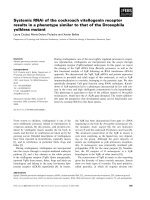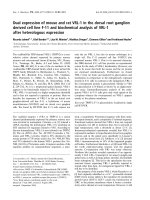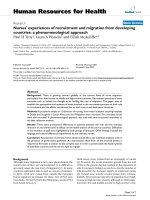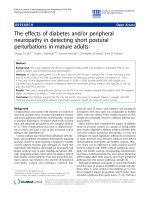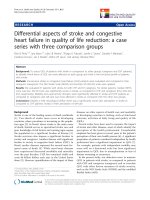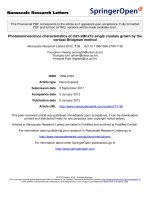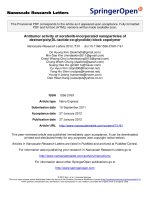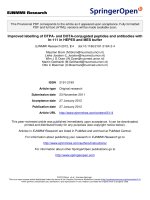Báo cáo toán học: " Selective preparation of zero- and onedimensional gold nanostructures in a TiO2 nanocrystal-containing photoactive mesoporous template" pdf
Bạn đang xem bản rút gọn của tài liệu. Xem và tải ngay bản đầy đủ của tài liệu tại đây (1.14 MB, 8 trang )
NANO EXPRESS Open Access
Selective preparation of zero- and one-
dimensional gold nanostructures in a TiO
2
nanocrystal-containing photoactive
mesoporous template
Go Kawamura
1*
, Teruhisa Okuno
2
, Hiroyuki Muto
1,2
and Atsunori Matsuda
1,2
Abstract
Nanocrystallized SiO
2
-TiO
2
with tubular mesopores was prepared via the sol-gel technique. Gold was deposited in
the tubular mesopores of the nanocrystallized SiO
2
-TiO
2
. The shape of the gold was varied from one-dimensional
[1-D] to zero-dimensional [0-D] nanostructures by an increase in TiO
2
content and ultraviolet [UV] irradiation during
gold deposition. 1-D gold nanostructures [GNSs] were mainly obtained in the mesopores when a small amount of
TiO
2
-containing mesoporous SiO
2
-TiO
2
was used as a template, whereas the use of a template containing a large
amount of TiO
2
led to the formation of shorter 1-D or 0-D GNSs. UV irradiation also resulted in the forma tion of 0-
D GNSs.
PACS: 06.60.Jn (sample preparation); 81.07.Gf (nanowires); 81.16.Be (chemical synthesis methods).
Keywords: mesoporous, titania, template, gold, nanostructures, shape control, photocatalysis, surface plasmon
resonance
Introduction
Gold nanostructures [GNSs] have been attracting much
attention because of the high chemical stability coinci-
dent with t heir unique optoelectronic properties, which
are dependent on the m orphology of the GNSs [1-4].
Surface plasmon r esonance [SPR] is one of the most
interesting properties of one-dimensional [1-D] GNSs
[2-5]. The wavelength of SPR is affected by the length,
diameter, and aspect ratio of the 1-D GNSs [6,7]. Aligned
GNSs perform polarization o f light [8-10]. Such multi-
functionality of the 1-D GNSs opens up new application
fields such as wavelength-sensitive nonlinear optical
devices and polarization filters [8,9,11]. Several methods
for synthesizing GNSs including 1-D GNSs have been
reported. These methods include photochemical and
electrochemical deposition [12,13] and seeding growth
methods [14,15]. In these methods, however, the GNSs
are suspended in a solvent. Therefore, the GNSs are
required to be immobilized in a designed fashion in/on a
solid matrix for various kinds of practical applications.
The immobilization p rocess for GNSs still r equires
further development [3,10,16].
On the other hand, the use of hard t emplates such as
anodic alumina and mesoporous silica for the synthesis of
1-D GNSs makes the complicated immobilization pro-
cesses redundant, and several related studies have been
reported [17,18]. Those methods using hard templates are
also advantageous to control the diameter and dispersion
state of 1-D GNSs because they depend on the pore struc-
ture. However, methods that control the morphology of
the 1-D GNSs have several problems. For example, the
elongation of the 1-D GNSs requires more gold to be
deposited in the template. This obstructs, for example, the
investigation of the shape-dependent properties of the
GNSs. Therefore, a novel method to control the morphol-
ogy of the 1-D GNSs in hard templates without changing
the gold amount is eagerly demanded.
In this work, nanocrystallized SiO
2
-TiO
2
with tubular
mesopores was prepared and used as an active template.
* Correspondence:
1
Department of Electrical and Electronic Information Engineering, Toyohashi
University of Technology, 1-1 Hibarigaoka, Tempaku-cho, Toyohashi, Aichi,
441-8580, Japan
Full list of author information is available at the end of the article
Kawamura et al. Nanoscale Research Letters 2012, 7:27
/>© 2012 Kawamura et al; licensee Springer. This is an Open Access article distributed under the terms of the Creative Commons
Attribution License ( ), which permits unrestricted use, distribution, and reproduction in
any medium, provided the original work is properly cited.
0-D and 1-D GNSs were deposited in the tubular meso-
pores. The shape of the GNSs was observed, and the
SPR characteristics were measured. It is known that
TiO
2
nanocrystals generate electrons through heating
and ultraviolet [UV] irradiation. In this study, the gener-
ated electrons were found to transfer to the Au
3+
ions.
As such, the deposition rate of the GNSs can be con-
trolled by controlling the amount of electrons generated.
As a result, 0-D and 1-D GNSs are selectively deposited.
Experimental methods
Materials
Pluronic P123 ((EO)
20
(PO)
70
(EO)
20
, poly(ethylene oxide),
and poly(propylene oxide)) was purchased from Sigma-
Aldrich (S t. Louis, MO, USA). Tetraethox ysilane [TEOS]
and 3-aminopropyltriethoxysilane [APTES] were obtained
from Shin-Etsu Chemical Co., Ltd. (Tokyo, Japan). Tita-
nium tetra-n-buto xide [TTB] and HAuCl
4
were acquired
from Wako Pure Chemical Industries, Ltd. (Osaka, Japan)
and Kishida (Osaka, Japan), respectively.
Synthesis of mesoporous template
The preparation procedure of 20Ti is described as a typi-
cal example. A mixtur e of P123 (1.74 g), NaCl (2.92 g),
and 1 mM HCl (100 mM) was added to TEOS (4.18 g)
and stirred at 35°C for 24 h. TTB (1.70 g) was then added
to the solution and stirred further for 6 h. For the pre-
paration of (100-x)S iO
2
·xTiO
2
, only the ratio of TEOS to
TTB was varied. The stirred solution was trans ferred into
an autoclave vessel and kept at 100°C for 4 h. The preci-
pitated powder w as collected by suction filtration, then
washed with ion-exchanged water [IEW] and ethanol,
and dried in an ambient environment. The obtained pow-
der was calcined a t 550°C for 5 h to remove th e surfac-
tant from the mesopore.
Loading of Au
The obtained powder was immersed in the 1 wt.% APTES
solution (in ethanol) and stirred at 25°C for 3 h. The pow-
der was then filtered with suction, washed with ethanol,
and dried at 60°C in air. The amino-functionalized powder
was mixed into a 1-mM HAuCl
4
aqueous solution and
stirred at 25°C for 2 h. After the suction filtration, the pro-
duct was washed with IEW and dried in an ambient envir-
onment. The product was then calcined at 350°C for 3 h
(at a heating rate of 1°C/min) with or without UV irradia-
tion (USHIO SP-9, 230-440 nm, 2.5 mW/cm
2
at 365 nm).
Characterization
X-ray diffraction [XRD] measurements were performed
using a Rigaku RINT 2000 diffractometer (Rigaku Cor-
poration, Tokyo, Japan) with CuKa radiation (l =
1.5406 Å). Transmission electron microscopy [TEM]
images and energy dispersive spectroscopy [ EDS] were
taken using a Hit achi H-800 transmission electron
microscope (High-Technologies Corporation, Chiyoda,
Tokyo, Japan) and a JEOL JEM-2100F (JEOL, Ltd.,
Akishima, Tokyo, Japan) transmission electron micro-
scope operating at 200 kV. UV/vis ible-near infrared dif-
fuse reflectance [Vis-NIR DR] spectra were measured
using a JASCO V-670 UV-Vis-NIR spectrosco pe
(JASCO Corporation, Tokyo, Japan).
Results and discussion
In the XRD pattern of the mesoporous 100SiO
2
templat e
[0Ti], amorphous SiO
2
was observed as a halo at ca. 23°.
On the other hand, the 80SiO
2
·20TiO
2
template [20Ti]
showed several peaks consistent with both anatase and
rutile TiO
2
,aswellasamorphousSiO
2
(Figure 1A). The
peaks of the TiO
2
crystals appeared stronger in the pattern
of the 50SiO
2
·50TiO
2
template [50Ti] in comparison with
those of 20Ti. A TEM observation of these templates
revealed that all of them possessed a 2-D hexagonal meso-
porous structure with the same caliber of ca. 7 nm
(Figures 1B, C, D). The high-resolution TEM images of
20Ti and 50Ti showed ca. 4-nm crystals with a fringe spa-
cing of 3. 52 Å, which were well dispersed in th e samples
(insets of Figures 1C, D). The fringe spacing is consistent
with the d value of {011} planes of anatase TiO
2
.This
proves that the templates consist of pure amorphous SiO
2
,
or SiO
2
and well-dispersed TiO
2
nanocrystals, for ming a
2-D hexagonal mesoporous structure.
Particles without mesopores were rarely observed in
the TEM images of 20Ti and 50Ti prepared by aging in
water at 100°C for 4 h. On the o ther hand, 20Ti (and
50Ti) aged fo r 24 h in water at 100°C showed the forma-
tion of large nonporous particles outside the mesoporous
structure (Figure 2A). The components of the nonporous
particles and mesoporous region were solely attributed to
TiO
2
and SiO
2
, respectively ( Figure 2B). Thus, the TiO
2
crystal formation in our samples should be based on the
dissolution and deposition of the TiO
2
component by
aging in hot water, where the TiO
2
component in the
SiO
2
-TiO
2
gel system is dissolved into water and then
reprecipitated as crystalline TiO
2
[19,20]. The short aging
time in hot water resulted in the suppression of large
TiO
2
particle formation and the sufficient deposition of
TiO
2
nanocrystals with a highly dispersed state on/in the
mesoporous matrix. In this w ork, therefore, the aging
time of 4 h was employed to prepare the templates,
whichpossessalmostthesameporesizeandstructure
regardless of the TiO
2
content. The molar ratio of SiO
2
to TiO
2
in the mesoporous region was checked by EDS,
and it was found to be comparab le to the nominal molar
ratio. By using the templates, the effect of the TiO
2
nano-
crystals on the shape of the 1-D GNSs can be investi-
gated due to the sufficient formation of interfaces
between the deposited Au and TiO
2
nanocrystals.
Kawamura et al. Nanoscale Research Letters 2012, 7:27
/>Page 2 of 8
Long 1-D GNSs were formed in 0Ti after Au loading
(Figure 3A). At the beginning of the Au loading, the Au
3+
ions adsorb to the amino groups on the wall of the meso-
pores. Heat treatment of the resultant powder causes
decomposition of the amino g roup-containing organic
matter. The Au
3+
ions are released and partly reduced to
Au
+
ions and Au atoms by electrons provided from the
decomposed organic matter. The Au atoms agglomerate
and form Au nanoclusters, and then the Au ions released
from the amino groups are reduced on the Au nanoclus-
ters by autocatalysis of Au [21,22], cau sing the Au metal
to grow. Since the growth of Au occurs in the tubular
mesopores, the final shape of the Au should be 1-D or 0-
D GNSs. A morphology change of the GNSs was then
investigated when the content of TiO
2
in the template was
varied. The length of the 1-D GNSs formed in 20Ti
(Figure 3B) was shorter than that deposited in 0Ti,
whereas 0-D GNSs were predominantly obtained in 50Ti
(Figure 3C). These results i ndicate that an i ncrease in
TiO
2
content leads to a shortening of the 1-D GNSs. This
is presumably because thermoexcited conduction elec-
trons are generated from TiO
2
, and these generated elec-
trons transfer to the Au ions to accelerate their reduction
[23]. TiO
2
heated at 350°C generates approximately 8.8 ×
10
13
times as many thermoexcited electrons as TiO
2
does
at room temperature [24]. Therefore, the amount of elec-
trons supplied to the Au ions increases as the TiO
2
con-
tent increases. As a result, Au metal is rapidly deposited
prior to its migration for the formation of long 1-D GNSs.
Therefore, 0-D GNSs were predominantly formed in the
tubular mesopores by using templates containing more
than 50 mol% TiO
2
.
Figure 1 XRD patterns and TEM images of 0Ti, 20Ti, and 50Ti.(A) XRD patterns of 0Ti, 20Ti, and 50Ti. (B-D) The corresponding TEM images
of the 0Ti, 20Ti, and 50Ti (scale bars, 50 nm). The insets in C and D are HR TEM images of the squared regions.
Kawamura et al. Nanoscale Research Letters 2012, 7:27
/>Page 3 of 8
1-D GNSs deposited in 0Ti showed two extinction
peaks in the diffuse reflectance [DR] spectrum: a sharp
extinction peak at 500 nm and a broad extinction peak
spreading over the whole region of the NIR region (Fig-
ure 3D). The shor ter- and longer-wavelength extinctions
are attributed to the transverse mode of SPR and the
light scattering by fairly long 1-D GNSs [25], respec-
tively. The length of the 1-D GNSs was shortened when
20Ti was used. An extinction peak appeared at around
600 nm, and the extinction intensity at wavelengths
longer than 1,200 nm increased. This is presumably due
to the shortening of the 1-D GNSs, which leads to a
decrease in the light scattering intensity of the long 1-D
GNSs (appearing over the whole NIR region) and an
increase in the longitudinal SPR [LSPR] mode caused by
the short 1-D GNSs (appearing at the NIR region
toward the shorter wavelength side, e.g. 600 nm and
approximately 2,000 nm in this case). With 30Ti, the
LSPR peaks blue-shifted and appeared at 580 and
approximately 900 nm. When 50Ti was used, only 0 -D
GNSs were deposited accompanied by a 520-nm peak,
which is attributed to the SPR of the 0-D GNSs. By the
use of a mesoporous SiO
2
template containing less than
30 mol% TiO
2
, 1-D GNSs exhibiting LSPR, which is
excited by NIR light, are deposited regardless of the pre-
sence of TiO
2
nanocrystallites in the template.
Since TiO
2
is known as a photocatalyst that generates
electrons and holes by UV irradiation, the effects of UV
irradiation during Au loading on the shape of the GNSs
were investigated. As for the TiO
2
crystalline phases,
anatase TiO
2
was widely recognized as the most suitable
pha se for photoca talysis [26,27]; but recent reports sug-
gest that mixed rather than single phases can be even
more active [28,29]. Also, since the TiO
2
nanocrystals in
our samples possess diameters of a few nanometers,
which are almost the optimum size for photocat alysis
[26], UV irradiation of the templates should generate
charges and influence the shape of the GNSs. In the
case where 0Ti was used, 1-D GNSs with a length of 10
to 100 nm were deposited regardless of the UV irradia-
tion (Figures 4A, B). It is worth mentioning that the 1-
D GNSs in 0Ti were fabricated with a short length by
shortening the calcination time in order to discuss the
shift of the resonant wavelength in the measurable NIR
region. In the DR spectra, the LSPR wavelengths of the
samples prepared with and without UV irradiation were
930 and 990 nm, respectively. The wavelengths were
slightly shifted, and the LSPR extinction intensity
decreased slightly upon UV i rradiation (Figure 4C). The
results reveal that UV irradiation has only a minor effect
on the shape of the deposited 1-D GNSs when 0Ti is
used. On the other hand, although 1-D GNSs with a
length of 10 to 400 nm were obtained in 20Ti without
UV irradiation (Figure 4D), 0-D GNSs were predomi-
nantly deposited when UV irradiation was carried out
(Figure 4E). The extinction peaks in the NIR region
almost disappeare d when the sample was exposed to
UV irradiation (Figure 4F). These results clearly show
that UV irradiation during Au loading in 20Ti influ-
ences the shape of the GNSs. Furthermore, since the
Figure 2 TEM image and Ti elemental mapping of 20 Ti.(A) Bright field TEM image and (B) Ti elemental mapping of 20Ti treated in water at
100°C for 24 h.
Kawamura et al. Nanoscale Research Letters 2012, 7:27
/>Page 4 of 8
GNSs are insensitive toward UV light, it is evident that
the photocatalytic activity of TiO
2
affects the shape of
the GNSs in the template.
Two mechanisms were considered for the preferential
formation of 0-D GNSs by UV irradiation: acceleration of
the Au-ion reduction rate by the generated electrons or
oxidation of deposited Au metal by the generated holes.
In the case where UV irradiation at room temperat ure
was carried out on the Au ion-adsorbed 20Ti, an increase
in extinction intensity was observed from the Vis to the
NIR region (Figure 5A). The increased extinction was
attributed to the formation of 1-D GNSs of various
lengths because of the wide wavelen gth region of SPR.
On the other hand, UV irradiation of 0Ti resulted in a
slight increase in extinction intensity over a similarly
wide wavelength region (Figure 5A). This is probably due
to the marginal deposition of GNSs by UV irradiation,
which partly decomposes the organic matter adsorbed on
the mesoporous wall, and thus, a small number of elec-
trons are generated that reduce Au ions. This would
explain the spectral change in Figure 4C, where the ther-
mal and photo decomposition of the organic matter
occurs simultaneously at the beginning of the Au loading
process; thus, the Au reduction rate is slightly increased.
Furthermore, since the variation of the extinction inten-
sity in 20Ti is much larger than that in 0Ti, it is clear
that UV irradiation accelerates the reduction of Au ions
as a result of the electrons generated from TiO
2
.Onthe
other hand, UV irradiation after the thermal deposition
of 1-D GNSs in 20Ti led to little change in the DR spec-
tra (Figure 5B). This indicates that the holes, which are
expected to oxidize the deposit ed 1-D GNSs to Au ions,
Figure 3 TEM images and DR spectra after Au deposition. TEM images of (A)0Ti,(B)20Ti,and(C) 50Ti after Au deposition (scale bars, 100
nm). (D) The corresponding DR spectra.
Kawamura et al. Nanoscale Research Letters 2012, 7:27
/>Page 5 of 8
have negligible effect on the shape change in the GNSs.
Thus, it is conclude d that the photocatalysis of TiO
2
causes the reduction of the gold ions rather than oxida-
tion of the Au metal. The generated holes may be con-
sumed to decompose organic matter adsorbed on the
wall of t he templa te. In addition, UV irradiation of the 1-
D GNSs deposited in 0Ti also resulted in n o change in
the DR spectra.
Theresultsobtainedsuggesttheprobablemechanism
of Au deposition by the simultaneous heat treatment and
UV irradiation, where the predominant formation of 0-D
GNSs was observed (Figure 4E). The heat treatment
causes the decomposition of organic matter adsorbed on
the wall of the template. This results in the partial reduc-
tion of Au
3+
ions, followed by the formation of scattered
Au nanoclusters. The partially reduced Au ions are
released from their electrostatic adsorption to the amino
groups and associated with the oxygen atoms on the wall
surface of the matrix, enabling mobility of the Au ions
[30]. The Au ions, therefore, can reach the neighboring
Au nanoclusters and are reduced on the surface of the
nanoclusters by autocataly sis of Au [21,22], resulting in
the formation of 1-D GNSs because the growth of A u
occurs in the tubular mesopores. Thermal ly excited elec-
trons of TiO
2
accelerate the reduction rate of the Au
ions; thus, a large content of TiO
2
in the template leads
to the preferential formation of 0-D GNSs. Furthermore,
UV irradiation also accelerates the reduction rate of the
Au ions. Therefore, the combination of heat treatment
and UV irradiation leads to a fast rate of Au deposition.
The time taken for the movement of the Au ions is shor-
tened, and the formation of 0-D GNSs instead of 1-D
GNSs becomes dominant. By optimizin g the heating and
UV irradiation condition of our method, 1-D and 0-D
GNSs are selectively deposited regardless of the composi-
tion of the template, where the amount of deposited Au
atoms is constant but the shape of the GNSs is different.
Conclusion
We have demonst rated the preparation of TiO
2
nano-
crystal-containing mesoporous t emplates and deposited
1-D or 0-D GNSs in the as-formed tubular mesopores.
Figure 4 TEM images of 0Ti and 20Ti with their corresponding DR spectra after Au deposition. TEM images of 0Ti after t hermal Au
deposition were carried out (A) Without or (B) with simultaneous UV irradiation. (C) The corresponding DR spectra of A and B. TEM images of
20Ti after thermal Au deposition was carried out (D) without or (E) with simultaneous UV irradiation. (F) The corresponding DR spectra of D and
E. (scale bars, 100 nm).
Kawamura et al. Nanoscale Research Letters 2012, 7:27
/>Page 6 of 8
Since the provision of thermally generated electrons
from TiO
2
increased when a templat e contained a large
amount of TiO
2
, Au ions were rapidly reduced and
deposited as shorter 1-D or 0-D GNSs. Similarly, UV
irradiation during Au deposition in the TiO
2
-containing
template produced electrons photocatalytically and
accelerated the Au deposition rate, leading to the domi-
nant formation of 0-D GNSs.
Abbreviations
APTES: 3-aminopropyltriethoxysilane; DR: diffuse reflectance; EDS: energy
dispersive spectroscopy; GNSs: gold nanostructures; HR: high-resolution; IEW:
ion-exchanged water; LSPR: longitudinal surface plasmon resonance; NIR:
near infrared; 1-D: one-dimensional; SPR: surface plasmon resonance; TEOS:
tetraethoxysilane; TEM: transmission electron microscopy; TTB: titanium tetra-
n-butoxide; UV: ultraviolet; Vis: visible; XRD: X-ray diffraction.
Acknowledgements
This work was supported by Grants-in-Aid for Young Scientists (Start-up)
21860045 and Young Scientists (B) 22760539 from the Japan Society for the
Promotion of Science (JSPS).
Author details
1
Department of Electrical and Electronic Information Engineering, Toyohashi
University of Technology, 1-1 Hibarigaoka, Tempaku-cho, Toyohashi, Aichi,
441-8580, Japan
2
Department of Environmental and Life Sciences, Toyohashi
University of Technology, 1-1 Hibarigaoka, Tempaku-cho, Toyohashi, Aichi,
441-8580, Japan
Authors’ contributions
GK, TO, and AM designed the study. TO performed the experiments with
help from GK and AM. GK and AM contributed in drafting the manuscript.
All authors edited and approved the manuscript.
Competing interests
The authors declare that they have no competing interests.
Received: 6 September 2011 Accepted: 5 January 2012
Published: 5 January 2012
References
1. Daniel MC, Astruc D: Gold nanoparticles: assembly, supramolecular
chemistry, quantum-size-related properties, and applications toward
biology, catalysis, and nanotechnology. Chem Rev 2004, 104:293.
2. Perez-Juste J, Pastoriza-Santos I, Liz-Marzan LM, Mulvaney P: Gold
nanorods: synthesis, characterization and applications. Coord Chem Rev
2005, 249:1870.
3. Kawamura G, Yong Y, Nogami M: Facile assembling of gold nanorods
with large aspect ratio and their surface-enhanced Raman scattering
properties. Appl Phys Lett 2007, 90:261908.
4. Kawamura G, Yong Y, Nogami M: End-to-end assembly of CTAB-stabilized
gold nanorods by citrate anions. J Phys Chem C 2008, 112:10632.
5. Mulvaney P, Perez-Juste J, Giersig M, Liz-Marzan LM, Pecharroman C: Drastic
surface plasmon mode shifts in gold nanorods due to electron charging.
Plasmonics 2006, 1:61.
6. Brioude A, Jiang XC, Pileni MP: Optical properties of gold nanorods: DDA
simulations supported by experiments. J Phys Chem B 2005, 109:13138.
7. Huang X, Neretina S, El-Sayed MA: Gold nanorods: from synthesis and
properties to biological and biomedical applications. Adv Mater 2009,
21:4880.
8. Wilson O, Wilson GJ, Mulvaney P: Laser writing in polarized silver nanorod
films. Adv Mater 2002, 14:1000.
9. Perez-Juste J, Rodriguez-Gonzalez B, Mulvaney P, Liz-Marzan LM: Optical
control and patterning of gold nanorod-poly(vinyl alcohol)
nanocomposite films. Adv Funct Mater 2005, 15:1065.
10. Murphy CJ, Orendorff CJ: Alignment of gold nanorods in polymer
composites and on polymer surfaces. Adv Mater 2005, 17:2173.
11. Tsutsui Y, Hayakawa T, Kawamura G, Nogami M: Tuned longitudinal
surface plasmon resonance and third-order nonlinear optical properties
of gold nanorods. Nanotechnology 2011, 22:275203.
Figure 5 DR spectra of Au
3+
ion-adsorbed 20Ti and 0Ti and of 1-D GNSs.(A)DRspectraofAu
3+
ion-adsorbed 20Ti and 0Ti before and
after UV irradiation (no heat treatment). (B) DR spectra of the 1-D GNSs thermally pre-deposited in 20Ti before and after UV irradiation.
Kawamura et al. Nanoscale Research Letters 2012, 7:27
/>Page 7 of 8
12. Esumi K, Matsuhisa K, Torigoe K: Preparation of rodlike gold particles by
UV irradiation using cationic micelles as a template. Langmuir 1995,
11:3285.
13. Yu YY, Chang SS, Lee CL, Wang CRC: Gold nanorods: electrochemical
synthesis and optical properties. J Phys Chem B 1997, 101:6661.
14. Jana NR, Gearheart L, Murphy CJ: Seed-mediated growth approach for
shape-controlled synthesis of spheroidal and rod-like gold nanoparticles
using a surfactant template. Adv Mater 2001, 13:1389.
15. Kawamura G, Nogami M: Application of a conproportionation reaction to
a synthesis of shape-controlled gold nanoparticles. J Cryst Growth 2009,
311:4462.
16. Gole A, Orendorff CJ, Murphy CJ: Immobilization of gold nanorods onto
acid-terminated self-assembled monolayers via electrostatic interactions.
Langmuir 2004, 20:7117.
17. Sawitowski T, Miquel Y, Heilmann A, Schmid G: Optical properties of quasi
one-dimensional chains of gold nanoparticles. Adv Funct Mater 2001,
11:435.
18. Li Z, Kubel C, Parvulescu VI, Richards R: Size tunable gold nanorods evenly
distributed in the channels of mesoporous silica. ACS Nano 2008, 2:1205.
19. Matsuda A, Kotani Y, Kogure K, Tatsumisago M, Minami T: Transparent
anatase nanocomposite films by the sol-gel process at low
temperatures. J Am Ceram Soc 2000, 83:229.
20. Kotani Y, Matsuda A, Tatsumisago M, Minami T, Umezawa T, Kogure T:
Formation of anatase nanocrystals in sol-gel derived TiO
2
-SiO
2
thin films
with hot water treatment. J Sol-Gel Sci Tech 2000, 19:585.
21. Rodriguez-Sanchez L, Blanco MC, Lopez-Quintela MA: Electrochemical
synthesis of silver nanoparticles. J Phys Chem B 2000, 104:9683.
22. Jana NR, Gearheart L, Murphy CJ: Evidence for seed-mediated nucleation
in the chemical reduction of gold salts to gold nanoparticles. Chem
Mater 2001, 13:2313.
23. Mizuguchi J: Titanium dioxide as a combustion-assisting agent. J
Electrochem Soc 2001, 148:J55.
24. Mizuguchi J, Shinbara T: Disposal of used optical disks utilizing thermally-
excited holes in titanium dioxide at high temperatures: a complete
decomposition of polycarbonate. J Appl Phys 2004, 96:3514.
25. Liz-Marzan LM: Tailoring surface plasmon resonance through the
morphology and assembly of metal nanoparticles. Langmuir 2006, 22:32.
26. Carreon MA, Choi SY, Mamak M, Choprab N, Ozin GA: Pore architecture
affects photocatalytic activity of periodic mesoporous nanocrystalline
anatase thin films. J Mater Chem 2007, 17:82.
27. Aprile C, Corma A, Garcia H: Enhancement of the photocatalytic activity
of TiO
2
through spatial structuring and particle size control: from
subnanometric to submillimetric length scale. Phys Chem Chem Phys
2008, 10:769.
28. Wu JM, Qi B: Low-temperature growth of a nitrogen-doped titania
nanoflower film and its ability to assist photodegradation of rhodamine
B in water. J Phys Chem C 2007, 111:666.
29. We JM, Antonietti A, Gross S, Bauer M, Smarsly BM: Ordered mesoporous
thin films of rutile TiO
2
nanocrystals mixed with amorphous Ta
2
O
5
.
Chem Phys Chem 2008, 9:748.
30. Matsubara K, Tatsuma T: Morphological changes and multicolor
photochromism of Ag nanoparticles deposited on single-crystalline TiO
2
surfaces. Adv Mater 2007, 19:2802.
doi:10.1186/1556-276X-7-27
Cite this article as: Kawamura et al.: Selective preparation of zero- and
one-dimensional gold nanostructures in a TiO
2
nanocrystal-containing
photoactive mesoporous template. Nanoscale Research Letters 2012 7:27.
Submit your manuscript to a
journal and benefi t from:
7 Convenient online submission
7 Rigorous peer review
7 Immediate publication on acceptance
7 Open access: articles freely available online
7 High visibility within the fi eld
7 Retaining the copyright to your article
Submit your next manuscript at 7 springeropen.com
Kawamura et al. Nanoscale Research Letters 2012, 7:27
/>Page 8 of 8
